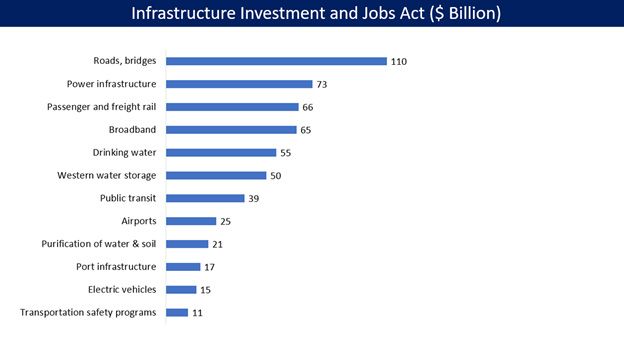In November 2021 President Biden signed a $1 trillion infrastructure package that includes funding to help America protect itself from the detrimental effects of climate change. The Infrastructure Investment and Jobs Act designates $50 million for climate resilience measures as well as funds to modernize and decarbonize U.S. transportation. This funding is a historic measure, but the $555 billion core of fulfilling Biden’s climate agenda is still awaiting passage in the Build Back Better Act. What does the current state of these two government actions mean for the future of federal leadership in addressing climate change?
Infrastructure Bill - Climate Change Measures
American cities and rural spaces are dependent on their infrastructure to run smoothly and be repaired quickly, even in the face of the ever-increasing dangers of sea level rise, extreme weather events, heat waves, and more. The Infrastructure Investment and Jobs Act is the biggest step in decades to help us meet that challenge. Here are some of the areas where the infrastructure bill will make the most impact on climate measures:
- Resilience: The bill pledges over $50 billion to help Americans protect from the effects of fire, flood and drought and invest in the weatherization of American homes. Other measures in the bill that modernize and improve our general infrastructure networks and airports are also useful in building up general climate-related weather resistance.
- Public Transit: The bill makes a large investment in passenger rail, one of Biden’s signature issues due in part to his love of train travel. The $66 billion investment will be the largest since the creation of Amtrak.
- Electric Vehicle Infrastructure: The bill will invest $7.5 billion to create a national network of EV chargers. This will help accelerate the adoption of electric vehicles by working to make long-distance EV travel practical and safe. The bill also plans to replace thousands of school buses with zero- and low-carbon electric buses made in America.
- Clean Energy Transmission: The bill makes a $65 billion investment in clean energy transmission and improving the electric grid. New and weather-resilient electric lines will help facilitate the use of renewable energy.
- Biodiversity: Many investments in this bill will indirectly benefit biodiversity by protecting habitats and carefully managing natural spaces.

Build Back Better Bill - Climate Change Measures
Despite the investments in climate change infrastructure promised by the infrastructure bill, the bulk of Biden’s planned climate commitments are in the $1.75 trillion Build Back Better bill. Due to the additional carbon emissions necessary to modernize and reinforce America’s infrastructure, the passage of the infrastructure bill on its own will only reduce annual carbon outputs slightly.
On November 19, the House passed their part of the Build Back Better Bill with a vote mostly along party lines, but it now waits in the Senate while legislators continue to negotiate. The bill includes $320 billion in tax incentives for clean energy investments, other incentives for manufacturing clean energy technologies, and the creation of a Civilian Climate Corps of 300,000 jobs to restore natural spaces and help climate change adaptation.
The infrastructure acts are a crucial move towards protecting our economy and infrastructure from the damage of climate change, but further measures are needed on the federal level to reduce our greenhouse gas emissions. The $555 billion for climate change measures included in the bill are a chance for the U.S. to get serious about its international climate commitments from negotiations such as the COP26 and Paris Agreement. The passage of both the Build Back Better Act and the Infrastructure Investment and Jobs Act would help Biden fulfill commitments such as:
- By 2030, reduce U.S. emissions by 50-52% from 2005 levels
- By 2035, create a 100% carbon fee power sector
- By 2050, achieve a net-zero economy